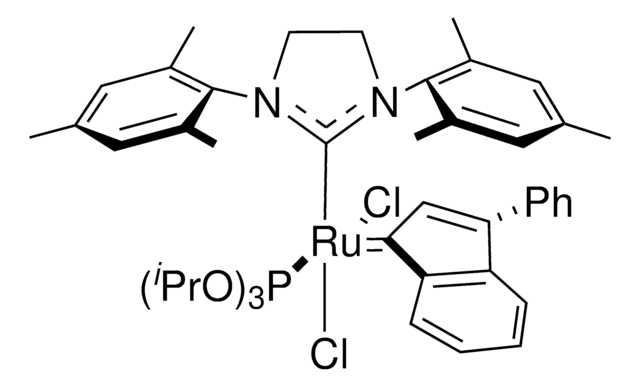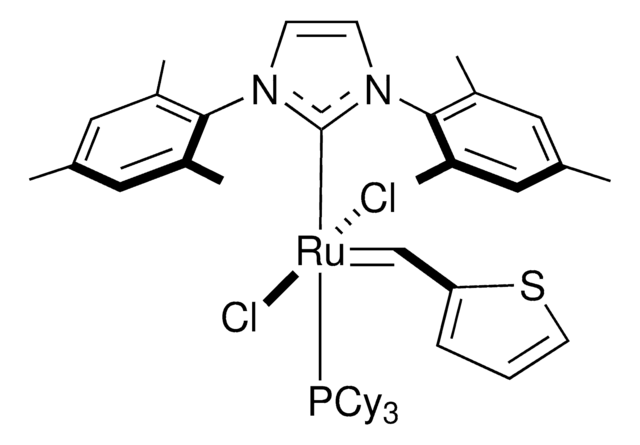All Photos(2)
About This Item
Empirical Formula (Hill Notation):
C12H19ClO2Ru
CAS Number:
Molecular Weight:
331.80
UNSPSC Code:
12161600
Recommended Products
form
powder or crystals
mp
141-147 °C
Application
[Ru(η3:η3-C10H16)Cl(μ2-O,O-O2CMe)] is a ruthenium catalyst developed for the redox-neutral isomerization of allylic alcohols to saturated carbonyls under physiological conditions. This bioorthoganol and biocompatible catalyst has also been shown to be active inside living cells.
Storage Class Code
11 - Combustible Solids
WGK
WGK 3
Flash Point(F)
Not applicable
Flash Point(C)
Not applicable
Choose from one of the most recent versions:
Certificates of Analysis (COA)
Lot/Batch Number
It looks like we've run into a problem, but you can still download Certificates of Analysis from our Documents section.
If you need assistance, please contact Customer Support.
Already Own This Product?
Find documentation for the products that you have recently purchased in the Document Library.
Nicolás Ríos-Lombardía et al.
Chemical communications (Cambridge, England), 51(54), 10937-10940 (2015-06-13)
The ruthenium-catalysed isomerisation of allylic alcohols was coupled, for the first time, with asymmetric bioamination in a one-pot process in an aqueous medium. In the cases involving prochiral ketones, the ω-TA exhibited excellent enantioselectivity, identical to that observed in the
Cristian Vidal et al.
Journal of the American Chemical Society, 141(13), 5125-5129 (2019-03-21)
Tailored ruthenium(IV) complexes can catalyze the isomerization of allylic alcohols into saturated carbonyl derivatives under physiologically relevant conditions, and even inside living mammalian cells. The reaction, which involves ruthenium-hydride intermediates, is bioorthogonal and biocompatible, and can be used for the
Nicolás Ríos-Lombardía et al.
Angewandte Chemie (International ed. in English), 55(30), 8691-8695 (2016-06-04)
The ruthenium-catalyzed redox isomerization of allylic alcohols was successfully coupled with the enantioselective enzymatic ketone reduction (mediated by KREDs) in a concurrent process in aqueous medium. The overall transformation, formally the asymmetric reduction of allylic alcohols, took place with excellent
Our team of scientists has experience in all areas of research including Life Science, Material Science, Chemical Synthesis, Chromatography, Analytical and many others.
Contact Technical Service![Dichlorodi-μ-chlorobis[(1,2,3,6,7,8-η-2,7-dimethyl-2,6-octadiene-1,8-diyl]diruthenium(IV) 97%](/deepweb/assets/sigmaaldrich/product/structures/183/511/879fb3f2-220a-45c9-bb2b-3799730a6693/640/879fb3f2-220a-45c9-bb2b-3799730a6693.png)
![Dichloro[(2,6,10-dodecatriene)-1,12-diyl]ruthenium(IV)](/deepweb/assets/sigmaaldrich/product/structures/769/292/dd2ea3dc-e365-49f0-b50d-5af33e2b10e9/640/dd2ea3dc-e365-49f0-b50d-5af33e2b10e9.png)



![(η5 -Cyclopentadienyl)[N,N-dimethyl-Ν′-(2-pyridinylmethylidene)propane-1,3-diamine]ruthenium hexafluorophosphate](/deepweb/assets/sigmaaldrich/product/structures/239/469/ed25f810-9a87-4608-889f-953f6422e452/640/ed25f810-9a87-4608-889f-953f6422e452.png)



